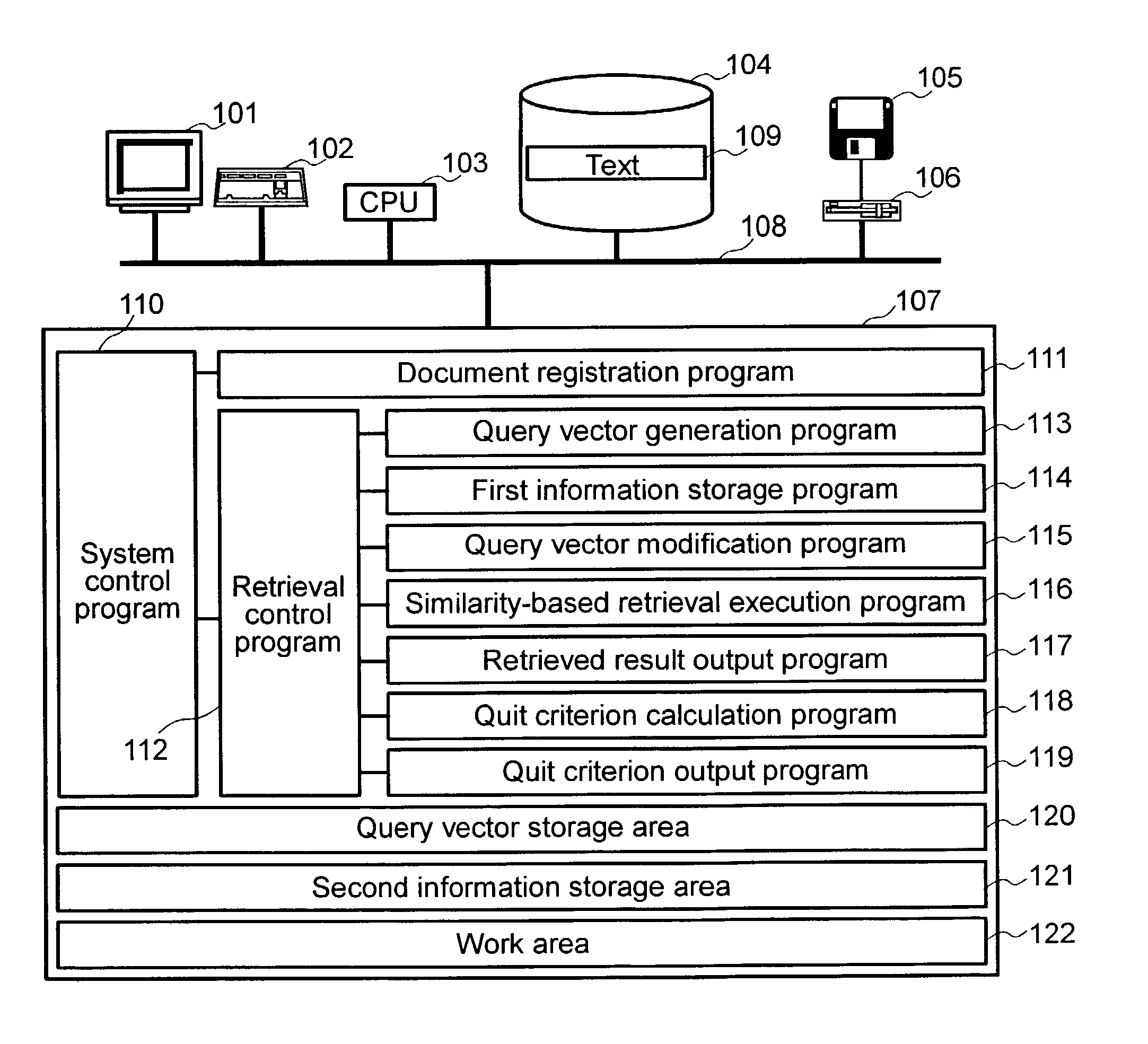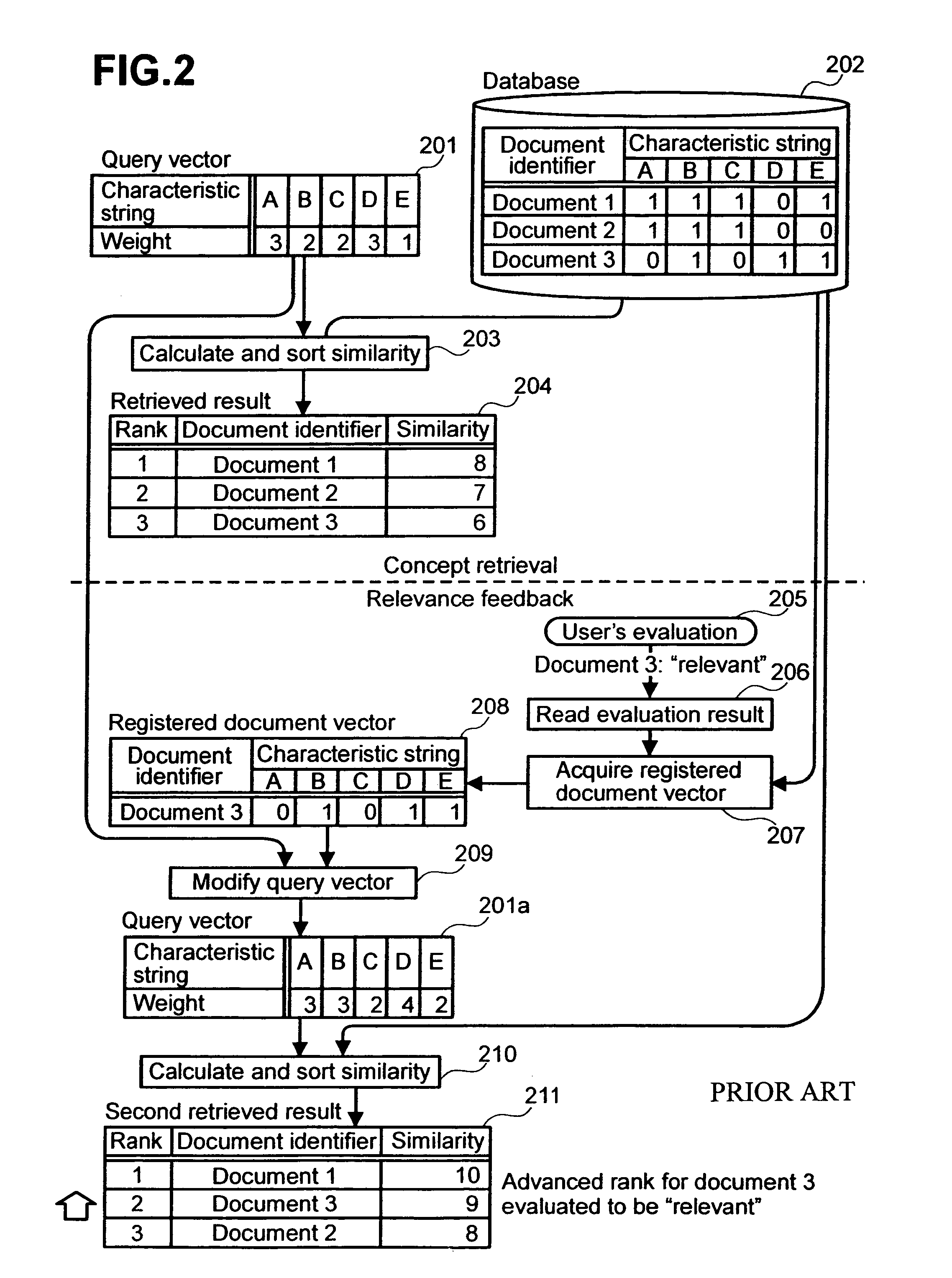Similarity-based search method by relevance feedback
a similarity-based search and relevance feedback technology, applied in the field of similarity-based search methods by relevance feedback, can solve the problems of difficult for users to determine when to terminate the retrieval, and the document retrieved is not relevant to their users
- Summary
- Abstract
- Description
- Claims
- Application Information
AI Technical Summary
Benefits of technology
Problems solved by technology
Method used
Image
Examples
first embodiment
[0057]The configuration of the first embodiment according to the present invention will now be described with reference to FIG. 1.
[0058]The document retrieval system according to the present embodiment comprises a display 101 to display retrieved results; a keyboard 102 to enter registration and retrieval commands and an evaluation in response to retrieved results; a central processing unit (CPU) 103 to process the registration and retrieval; a magnetic disk apparatus 104 to store various data; a floppy disk drive (FDD) 106 to read various programs and data from a floppy disk 105; a main memory 107 to temporarily store registration and retrieval programs and data; and a bus 108 to couple these components with each other.
[0059]The magnetic disk apparatus 104 is one of secondary storage apparatuses and stores text 109. Information stored in the floppy disk 105 is read into the main memory 107 or the magnetic disk apparatus 104 via the FDD 106. It is also possible to store a program fo...
third embodiment
[0141]The third embodiment will now be described. In the relevance feedback retrieval method, each time a retrieval is conducted, weights for the query vector increases while weights for the registered document vector evaluated to be “relevant” remain unchanged. Accordingly, repeating a retrieval increases a weight difference between the registered document vector and the query vector.
[0142]If the weight difference increases, performing the relevance feedback does not change query vector directions significantly, causing a state of unchanged retrieved results (hereafter referred to as a “converged state”).
[0143]When the converged state results, a user must quit the relevance feedback. When the retrieved result is unsatisfactory, it is necessary to retry the relevance feedback or reexamine the retrieval technique itself.
second embodiment
[0144]When the query vector shows no change the user cannot determine whether to quit the retrieval because the converged state has been reached or to continue the retrieval by evaluating the other documents instead of evaluating the retrieval-oriented documents having similar query vectors.
[0145]To address this concern, the third embodiment calculates a quit criterion not after, but before the retrieval and provides the quit criterion to a user in advance.
[0146]The embodiment configuration will be described with reference to FIG. 13. The retrieval process of the third embodiment is similar to the retrieval process of the first embodiment, as illustrated in FIG. 1, except that a prediction quit criterion program is executed at a quit criterion calculation step (i.e., at the step corresponding to the step 118). The third embodiment uses a predicted quit criterion calculation program 124, instead of the quit criterion calculation program 118. The retrieval process of the third embodi...
PUM
 Login to View More
Login to View More Abstract
Description
Claims
Application Information
 Login to View More
Login to View More - R&D
- Intellectual Property
- Life Sciences
- Materials
- Tech Scout
- Unparalleled Data Quality
- Higher Quality Content
- 60% Fewer Hallucinations
Browse by: Latest US Patents, China's latest patents, Technical Efficacy Thesaurus, Application Domain, Technology Topic, Popular Technical Reports.
© 2025 PatSnap. All rights reserved.Legal|Privacy policy|Modern Slavery Act Transparency Statement|Sitemap|About US| Contact US: help@patsnap.com



